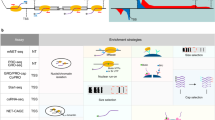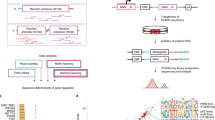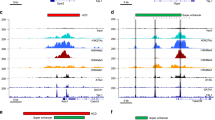Abstract
Promoters and enhancers establish precise gene transcription patterns. The development of functional approaches for their identification in mammalian cells has been complicated by the size of these genomes. Here we report a high-throughput functional assay for directly identifying active promoter and enhancer elements called FIREWACh (Functional Identification of Regulatory Elements Within Accessible Chromatin), which we used to simultaneously assess over 80,000 DNA fragments derived from nucleosome-free regions within the chromatin of embryonic stem cells (ESCs) and identify 6,364 active regulatory elements. Many of these represent newly discovered ESC-specific enhancers, showing enriched binding-site motifs for ESC-specific transcription factors including SOX2, POU5F1 (OCT4) and KLF4. The application of FIREWACh to additional cultured cell types will facilitate functional annotation of the genome and expand our view of transcriptional network dynamics.
This is a preview of subscription content, access via your institution
Access options
Subscribe to this journal
Receive 12 print issues and online access
$259.00 per year
only $21.58 per issue
Buy this article
- Purchase on Springer Link
- Instant access to full article PDF
Prices may be subject to local taxes which are calculated during checkout





Similar content being viewed by others
Accession codes
References
Landolin, J.M. et al. Sequence features that drive human promoter function and tissue specificity. Genome Res. 20, 890–898 (2010).
Hardison, R.C. & Taylor, J. Genomic approaches towards finding cis-regulatory modules in animals. Nat. Rev. Genet. 13, 469–483 (2012).
Patwardhan, R.P. et al. Massively parallel functional dissection of mammalian enhancers in vivo. Nat. Biotechnol. 30, 265–270 (2012).
Melnikov, A. et al. Systematic dissection and optimization of inducible enhancers in human cells using a massively parallel reporter assay. Nat. Biotechnol. 30, 271–277 (2012).
Akhtar, W. et al. Chromatin position effects assayed by thousands of reporters integrated in parallel. Cell 154, 914–927 (2013).
Mogno, I., Kwasnieski, J.C. & Cohen, B.A. Massively parallel synthetic promoter assays reveal the in vivo effects of binding site variants. Genome Res. 23, 1908–1915 (2013).
Yaragatti, M., Basilico, C. & Dailey, L. Identification of active transcriptional regulatory modules by the functional assay of DNA from nucleosome-free regions. Genome Res. 18, 930–938 (2008).
Murtha, M., Wang, Y., Basilico, C. & Dailey, L. Isolation and analysis of DNA derived from nucleosome-free regions. Methods Mol. Biol. 977, 35–51 (2013).
Cockerill, P.N. Structure and function of active chromatin and DNase I hypersensitive sites. FEBS J. 278, 2182–2210 (2011).
Jaenisch, R. & Young, R. Stem cells, the molecular circuitry of pluripotency and nuclear reprogramming. Cell 132, 567–582 (2008).
Bernstein, B.E. et al. A bivalent chromatin structure marks key developmental genes in embryonic stem cells. Cell 125, 315–326 (2006).
Chen, X. et al. Integration of external signaling pathways with the core transcriptional network in embryonic stem cells. Cell 133, 1106–1117 (2008).
Shen, Y. et al. A map of the cis-regulatory sequences in the mouse genome. Nature 488, 116–120 (2012).
Lois, C., Hong, E.J., Pease, S., Brown, E.J. & Baltimore, D. Germline transmission and tissue-specific expression of transgenes delivered by lentiviral vectors. Science 295, 868–872 (2002).
Yuan, H., Corbi, N., Basilico, C. & Dailey, L. Developmental-specific activity of the FGF-4 enhancer requires the synergistic action of Sox2 and Oct-3. Genes Dev. 9, 2635–2645 (1995).
McLean, C.Y. et al. GREAT improves functional interpretation of cis-regulatory regions. Nat. Biotechnol. 28, 495–501 (2010).
Voigt, P., Tee, W.-W. & Reinberg, D. A double take on bivalent promoters. Genes Dev. 27, 1318–1338 (2013).
Marks, H. et al. The transcriptional and epigenomic foundations of ground state pluripotency. Cell 149, 590–604 (2012).
Rada-Iglesias, A. et al. A unique chromatin signature uncovers early developmental enhancers in humans. Nature 470, 279–283 (2011).
Visel, A. et al. ChIP-seq accurately predicts tissue-specific activity of enhancers. Nature 457, 854–858 (2009).
Ernst, J. & Kellis, M. Discovery and characterization of chromatin states for systematic annotation of the human genome. Nat. Biotechnol. 28, 817–825 (2010).
Heintzman, N.D. et al. Distinct and predictive chromatin signatures of transcriptional promoters and enhancers in the human genome. Nat. Genet. 39, 311–318 (2007).
Whyte, W.A. et al. Master transcription factors and mediator establish super-enhancers at key cell identity genes. Cell 153, 307–319 (2013).
Chen, C.-Y., Morris, Q. & Mitchell, J.A. Enhancer identification in mouse embryonic stem cells using integrative modeling of chromatin and genomic features. BMC Genomics 13, 152 (2012).
Visel, A., Minovitsky, S., Dubchak, I. & Pennachio, L.A. VISTA Enhancer Browser—a database of tissue-specific human enhancers. Nucleic Acids Res. 35, D88–D92 (2007).
Bailey, T.L. et al. MEME SUITE: tools for motif discovery and searching. Nucleic Acids Res. 37, W202–W208 (2009).
Visel, A., Rubin, E.M. & Pennacchio, L.A. Genomic views of distant-acting enhancers. Nature 461, 199–205 (2009).
Pennacchio, L.A. et al. In vivo enhancer analysis of human conserved non-coding sequences. Nature 444, 499–502 (2006).
Nam, J., Dong, P., Tarpine, R., Istrail, S. & Davidson, E.H. Functional cis-regulatory genomics for systems biology. Proc. Natl. Acad. Sci. USA 107, 3930–3935 (2010).
Arnold, C.D. et al. Genome-wide quantitative enhancer activity maps identified by STARR-seq. Science 339, 1074–1077 (2013).
Gisselbrecht, S.S. et al. Highly parallel assays of tissue-specific enhancers in whole Drosophila embryos. Nat. Methods 10, 774–780 (2013).
Herold, M., Bartkuhn, M. & Renkawitz, R. CTCF: insights into insulator function during development. Development 139, 1045–1057 (2012).
Charrier, S. et al. Quantification of lentiviral vector copy numbers in individual hematopoietic colony-forming cells shows vector dose-dependent effects on the frequency and level of transduction. Gene Ther. 18, 479–487 (2011).
Caporaso, J.G. et al. Global patterns of 16S rRNA diversity at a depth of millions of sequences per sample. Proc. Natl. Acad. Sci. USA 108 (suppl. 1), 4516–4522 (2011).
Li, H. & Durbin, R. Fast and accurate long-read alignment with Burrows-Wheeler transform. Bioinformatics 26, 589–595 (2010).
Langmead, B., Trapnell, C., Pop, M. & Salzberg, S.L. Ultrafast and memory-efficient alignment of short DNA sequences to the human genome. Genome Biol. 10, R25 (2009).
Kruskal, W.H. & Wallis, W.A. Use of ranks in one-criterion variance analysis. J. Am. Stat. Assoc. 47, 583–621 (1952).
Gao, Z. et al. PCGF homologs, CBX proteins, and RYBP define functionally distinct PRC1 family complexes. Mol. Cell 45, 344–356 (2012).
Mathelier, A. et al. JASPAR 2014: an extensively expanded and updated open-access database of transcription factor binding profiles. Nucleic Acids Res. 42, D142–D147 (2014).
Matys, V. et al. TRANSFAC and its module TRANSCompel: transcriptional gene regulation in eukaryotes. Nucleic Acids Res. 34, D108–D110 (2006).
Acknowledgements
We thank A. Heguy, E. Mazzoni, M. Stadtfeld, D. Smith and U. Basu-Roy for their critical reading of this manuscript. We also thank A. Mansukhani and members of the Skok laboratory for helpful discussions, and the Genome Technology Center and Flow Cytometry and Cell Sorting Center at New York University Langone Medical Center for technical assistance. This work was supported by an Empire State Stem Cell Board grant through the New York State Department of Health (NYSTEM Contract #CO24322) to L.D. and a postdoctoral fellowship from US National Institutes of Health NCI institutional training grant 1T32CA160002 awarded to M.M.
Author information
Authors and Affiliations
Contributions
L.D. conceived of and designed the study; Y.W. constructed the NFR-GFP-LV reporter libraries and viral stocks; M.M. developed the FIREWACh technology and generated all cell lines, FACS sorting and PCR rescue and analysis of FIREWACh elements; Z.T. performed all processing and genomic alignment of Illumina data; S.B. generated the in silico DNA data sets; Z.T.-K. and X.X. performed luciferase assays; C.B. contributed to critical discussions; X.C., F.S., Y.K. and R.B. provided bioinformatic support and analyses; and M.M. and L.D. wrote the manuscript with additional contributions from X.C. and R.B.
Corresponding author
Ethics declarations
Competing interests
The authors declare no competing financial interests.
Supplementary information
Supplementary Text and Figures
Supplementary Figures 1–10 and Supplementary Note (PDF 1871 kb)
Supplementary Table 1
Genomic Coordinates for in silico DNAs, input NFR Library DNAs, FIREWACh Elements (XLSX 10 kb)
Supplementary Table 2
Sequencing Statistics (XLSX 4111 kb)
Supplementary Table 3
Luciferase Validated Elements (XLSX 32 kb)
Supplementary Table 4
Primer Sequences (XLSX 12 kb)
Supplementary Table 5
Datasets Used (XLSX 48 kb)
Supplementary Table 6
GREAT Analysis (XLSX 10 kb)
Supplementary Table 7
Full Motif Analysis (XLSX 2730 kb)
Rights and permissions
About this article
Cite this article
Murtha, M., Tokcaer-Keskin, Z., Tang, Z. et al. FIREWACh: high-throughput functional detection of transcriptional regulatory modules in mammalian cells. Nat Methods 11, 559–565 (2014). https://doi.org/10.1038/nmeth.2885
Received:
Accepted:
Published:
Issue Date:
DOI: https://doi.org/10.1038/nmeth.2885
This article is cited by
-
GATA transcription factors drive initial Xist upregulation after fertilization through direct activation of long-range enhancers
Nature Cell Biology (2023)
-
Using Synthetic DNA Libraries to Investigate Chromatin and Gene Regulation
Chromosoma (2023)
-
Massively parallel RNA device engineering in mammalian cells with RNA-Seq
Nature Communications (2019)
-
High-throughput screening of prostate cancer risk loci by single nucleotide polymorphisms sequencing
Nature Communications (2018)
-
Sort-seq under the hood: implications of design choices on large-scale characterization of sequence-function relations
BMC Genomics (2016)



